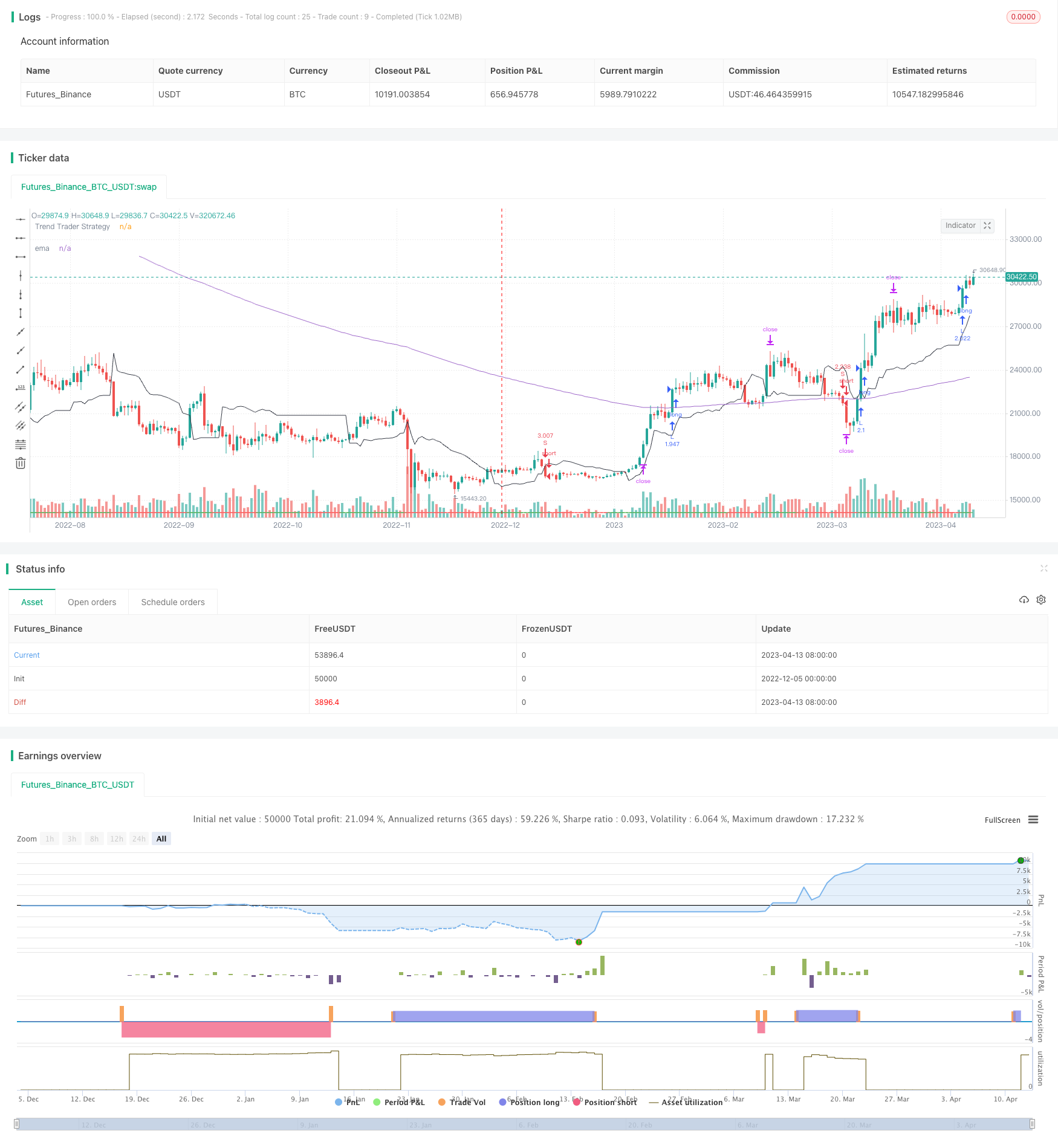
概述
该策略综合利用了指标EMA、趋势跟踪策略TTS和舒弗特趋势周期STC三者指标的优势,形成了一个较强的短线跟踪趋势的策略。具体来说,策略会同时判断三个指标的多空信号是否一致,如果一致就产生交易信号;如果不一致,则不进行买卖。这样可以过滤掉一些假信号,使得策略更加可靠。
策略原理
该策略主要由三部分组成:EMA平滑指标、TTS趋势跟踪策略和STC舒弗特趋势周期指标。
首先,计算200周期的EMA指数移动平均线,判断价格是否低于或高于该EMA线,如果价格低于该线,则EMA指标给出空头信号;-1;如果价格高于该线,EMA指标给出多头信号:1。
其次,计算TTS趋势跟踪策略的相关参数,根据价格突破上下轨,判断行情趋势方向。如果价格突破上轨,产生多头信号1;如果价格突破下轨,产生空头信号-1。
最后,计算舒弗特趋势周期STC指标,该指标反映了价格中枢的变化趋势。如果STC指标上涨,产生多头信号1;如果STC指标下跌,产生空头信号-1。
在得到三个指标的judgment信号后,策略会判断它们是否一致。只有当三个指标judgment信号全部一致时,才会产生实际的交易信号。这可以有效过滤掉一些假信号,使策略更可靠。
如果确定产生交易信号后,就进行做多或做空的委托,并设置止盈止损点。
策略优势
该策略综合运用了三种不同类型的指标,可以有效判断市场趋势方向。
利用三种指标judgment信号的一致性判断来过滤假信号,可以减少不必要的交易,使策略更可靠。
设置合理的止盈止损点,可以锁定盈利,避免亏损扩大。
选取的参数均经过优化,可以适应大部分股票及外汇品种。
交易逻辑清晰简洁,易于理解与修改。
策略风险
三种指标judgment之间不一致时,会出现 dimers,容易错过交易机会。可以考虑优化judgment规则。
STC指标对参数敏感度较高,不同的品种需要调整参数。
衰退行情中,止损可能被突破,造成较大亏损。可以考虑实时优化止损点。
无法有效判断横盘整理的行情,整理区间入场可能造成套牢。
策略优化
可以测试更多指标的组合,寻找更强的judgment规则。例如加入RSI指标等。
优化STC指标的指标参数,使其更适合不同品种。加入自适应参数优化模块。
增加自适应止损模块,可以根据行情实时优化设置止损点。
增强平仓模块,判断是否进入横盘整理,避免套牢。
针对高频交易进行算法优化,降低系统延迟,提升委托成功率。
总结
该策略综合运用EMA、TTS和STC三个指标判断行情趋势方向, judgment规则设置为三者一致时产生交易信号,这样可以有效过滤假信号。策略优化空间还很大,通过测试更多指标组合、加入自适应算法、优化高频交易模块等手段,进一步强化该策略在跟踪趋势过程中的表现。相比于简单追随均线等传统策略,该策略可以更加智能地判断市场,在抓住趋势的同时尽量避免被套。
/*backtest
start: 2022-12-05 00:00:00
end: 2023-04-14 00:00:00
period: 1d
basePeriod: 1h
exchanges: [{"eid":"Futures_Binance","currency":"BTC_USDT"}]
*/
// This source code is subject to the terms of the Mozilla Public License 2.0 at https://mozilla.org/MPL/2.0/
// © ajahanbin1374
//@version=5
strategy(title = "EMA + TTS + STC", shorttitle = "EMA + TTS + STC", overlay = true, calc_on_order_fills=false, calc_on_every_tick = false, initial_capital = 100, default_qty_type = strategy.percent_of_equity, default_qty_value = 100, commission_type = strategy.commission.percent, commission_value = 0.01)
////////////////////////////////////////////////////////////
// Strategy entry
////////////////////////////////////////////////////////////
profit = input.float(defval = 0.1, minval = 0.0, title="Profit %", step=0.01, group = "Strategy") * 0.01
////////////////////////////////////////////////////////////
// Emponential Moving Average
////////////////////////////////////////////////////////////
ema = ta.ema(close, 200)
posEma = close < ema ? -1 : 1
////////////////////////////////////////////////////////////
// Trend Trader Strategy
////////////////////////////////////////////////////////////
Length = input.int(21, minval=1, group="Trend Trader Strategy")
Multiplier = input.float(3, minval=0.000001, group="Trend Trader Strategy")
avgTR = ta.wma(ta.atr(1), Length)
highestC = ta.highest(Length)
lowestC = ta.lowest(Length)
hiLimit = highestC[1] - avgTR[1] * Multiplier
loLimit = lowestC[1] + avgTR[1] * Multiplier
ret = 0.0
posTts = 0.0
ret:= close > hiLimit and close > loLimit ? hiLimit :
close < loLimit and close < hiLimit ? loLimit : nz(ret[1], close)
posTts:= close > ret ? 1 :close < ret ? -1 : nz(posTts[1], 0)
////////////////////////////////////////////////////////////
// Schaff Trend Cycle (STC)
////////////////////////////////////////////////////////////
EEEEEE = input.int(12, 'Length', group ="Schaff Trend Cycle")
BBBB = input.int(26, 'FastLength', group ="Schaff Trend Cycle")
BBBBB = input.int(50, 'SlowLength', group ="Schaff Trend Cycle")
AAAA(BBB, BBBB, BBBBB) =>
fastMA = ta.ema(BBB, BBBB)
slowMA = ta.ema(BBB, BBBBB)
AAAA = fastMA - slowMA
AAAA
AAAAA(EEEEEE, BBBB, BBBBB) =>
AAA = input.float(0.5, group ="Schaff Trend Cycle")
var CCCCC = 0.0
var DDD = 0.0
var DDDDDD = 0.0
var EEEEE = 0.0
BBBBBB = AAAA(close, BBBB, BBBBB)
CCC = ta.lowest(BBBBBB, EEEEEE)
CCCC = ta.highest(BBBBBB, EEEEEE) - CCC
CCCCC := CCCC > 0 ? (BBBBBB - CCC) / CCCC * 100 : nz(CCCCC[1])
DDD := na(DDD[1]) ? CCCCC : DDD[1] + AAA * (CCCCC - DDD[1])
DDDD = ta.lowest(DDD, EEEEEE)
DDDDD = ta.highest(DDD, EEEEEE) - DDDD
DDDDDD := DDDDD > 0 ? (DDD - DDDD) / DDDDD * 100 : nz(DDDDDD[1])
EEEEE := na(EEEEE[1]) ? DDDDDD : EEEEE[1] + AAA * (DDDDDD - EEEEE[1])
EEEEE
mAAAAA = AAAAA(EEEEEE, BBBB, BBBBB)
mColor = mAAAAA > mAAAAA[1] ? color.new(color.green, 20) : color.new(color.red, 20)
posStc = mAAAAA > mAAAAA[1] ? 1 : -1
////////////////////////////////////////////////////////////
// Strategy entry
////////////////////////////////////////////////////////////
pos = posEma == 1 and posTts == 1 and posStc == 1 ? 1 : posEma == -1 and posTts == -1 and posStc == -1 ? -1 : 0
currentPostition = strategy.position_size > 0 ? 1 : strategy.position_size < 0 ? -1 : 0
noOpenPosition = strategy.position_size == 0
signal = pos != pos[1] and pos == 1 and noOpenPosition ? 1 : pos != pos[1] and pos == -1 and noOpenPosition ? -1 : 0
stopPriceForLong = math.min(close * (1 - profit), low[1] * 0.9998, low[2] * 0.9998)
limitPriceForLong = close + (close - stopPriceForLong)
stopPriceForShort = math.max(close * (1 + profit), high[1] * 1.0002, high[2] * 1.0002)
limitPriceForShort = close - (stopPriceForShort - close)
if signal == 1
strategy.entry(id="L", direction=strategy.long)
strategy.exit(id='EL', from_entry='L', limit=limitPriceForLong, stop=stopPriceForLong)
if signal == -1
strategy.entry(id="S", direction=strategy.short)
strategy.exit(id='ES', from_entry='S', limit=limitPriceForShort, stop=stopPriceForShort)
////////////////////////////////////////////////////////////
// Plots - Debuger
////////////////////////////////////////////////////////////
plotchar(signal, title='singal', char = '')
plotchar(posEma, title='posEma', char = '')
plotchar(posTts, title='posTts', char = '')
plotchar(pos, title='pos', char = '')
plotchar(currentPostition, title = 'currentPostition', char='')
plotchar(stopPriceForLong, title = "stopPriceForLong", char ='')
plotchar(limitPriceForLong, title = 'limitPriceForLong', char='')
plotchar(stopPriceForShort, title = "stopPriceForShort", char ='')
plotchar(limitPriceForShort, title = 'limitPriceForShort', char='')
////////////////////////////////////////////////////////////
// Plots
////////////////////////////////////////////////////////////
plot(ret, color=color.new(color.black, 0), title='Trend Trader Strategy')
plotchar(mAAAAA, color=mColor, title='STC', location = location.bottom, char='-', size=size.normal)
plot(series = ema, title = "ema")